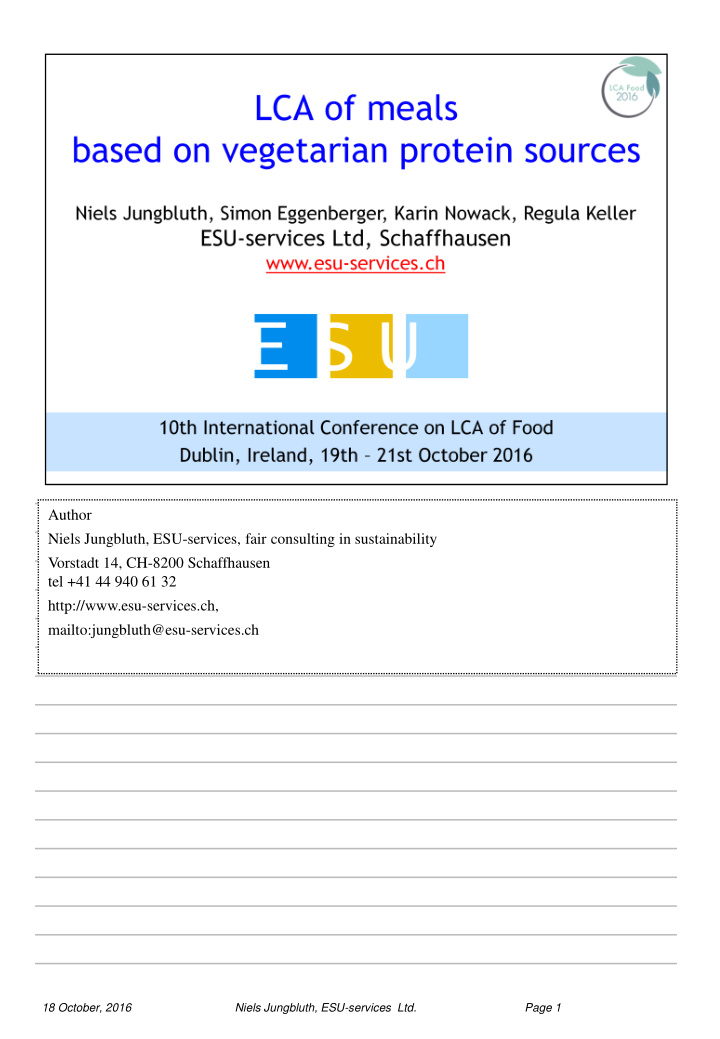



Author Niels Jungbluth, ESU-services, fair consulting in sustainability Vorstadt 14, CH-8200 Schaffhausen tel +41 44 940 61 32 http://www.esu-services.ch, mailto:jungbluth@esu-services.ch 18 October, 2016 Niels Jungbluth, ESU-services Ltd. Page 1
18 October, 2016 Niels Jungbluth, ESU-services Ltd. Page 2
18 October, 2016 Niels Jungbluth, ESU-services Ltd. Page 3
The investigation covers all life cycle stages from agricultural production, processing, distribution, transportation to home, cooling and preparation of the product. Food waste in different stages of the life cycle (but not including food waste after preparation of the meal) is assessed with standard factors for product categories (Flury, Jungbluth et al. 2013). 18 October, 2016 Niels Jungbluth, ESU-services Ltd. Page 4
Signet Vegan: http://indian-mango-specials.com/vegan-menu-card-online/ Signet Vegetarisch: http://all-free-download.com/free-vector/vector-symbol-vegetarian.html 18 October, 2016 Niels Jungbluth, ESU-services Ltd. Page 5
18 October, 2016 Niels Jungbluth, ESU-services Ltd. Page 6
18 October, 2016 Niels Jungbluth, ESU-services Ltd. Page 7
SE: In the LCA Food Conference Paper we also mention Global warming potential (IPCC GWP 100a), as it is noted in the report for FOEN. However, no Impact Assessment was made with GWP/IPCC (not in the results, so not in the FOEN report either). 18 October, 2016 Niels Jungbluth, ESU-services Ltd. Page 8
Impact per Portion • Other ingredients than the main protein sources are shown in a separate section or as part of the consumption. • For some products the agricultural production (Protein Source) is the dominant stage in the life cycle e.g. sun flower seeds . • Impacts for some other products, e.g. canned chickpeas, are dominated by the processing or packaging. • Environmental impacts of the meals are often considerably influenced by other ingredients than the protein source. • The protein source is mainly relevant in case of the meal with quorn and for the Bircher muesli. 18 October, 2016 Niels Jungbluth, ESU-services Ltd. Page 9
Impact per Gram Protein • Evaluating the environmental impacts for one portion does not reflect differences in nutritional values. • Figure 2 shows the impacts per gram of protein. • Differences between different meals get less pronounced (but still the meal with quorn, which includes a large share of protein from eggs, shows the highest impacts) • Mushrooms show rather high impacts due to their low protein content. • If environmental impacts are assessed in relation to the protein content, it is also important to take the biological value of the proteins for nutrition into account . • For single ingredients the biological value is lower than for different well combined protein sources. • In order to achieve a high biological value and thus a high availability of proteins it is necessary to smartly combine different food products (e.g. rice and lentils, maize and beans, potatoes and milk). This helps to cover the amount of essential amino acids required. The recipes used in this study are based on such considerations. 18 October, 2016 Niels Jungbluth, ESU-services Ltd. Page 10
Impact er 100 kcal • Again mushrooms have a low nutritional value and thus higher impacts than other single ingredients or meals. • The ranking between different meals changes with this functional unit (e.g. quorn does not have so much higher environmental impacts anymore). 18 October, 2016 Niels Jungbluth, ESU-services Ltd. Page 11
comparison with other “typical” meals 18 October, 2016 Niels Jungbluth, ESU-services Ltd. Page 12
This pilot study shows that the impact of vegetable protein products can only be comprehensively assessed when considering the later usage in a meal that is ready for consumption. An evaluation at a preliminary production stage or at the level of a single ingredient is not sufficient for a comprehensive assessment because the combination of protein rich products with other ingredients has a decisive effect on the nutritional value and the environmental impact. Another conclusion of the study is that the environmental impact of food should be specified not only per kilogram or per portion but also per nutrient content. This study investigates only some examples of products rich in vegetable proteins. The results of this study for some individual examples still do not allow general statements for the evaluation of vegetable proteins from an environmental perspective. The study lays the foundation for more detailed assessments by developing the necessary methodology and providing transparent data. Furthermore, the data are used for studying the environmental impacts of food consumption patterns (Jungbluth, Eggenberger et al. 2016). 18 October, 2016 Niels Jungbluth, ESU-services Ltd. Page 13
http://esu-services.ch/projects/lcafood/proteins/ 18 October, 2016 Niels Jungbluth, ESU-services Ltd. Page 14
15 18 October, 2016 Niels Jungbluth, ESU-services Ltd. Page 15
Recommend
More recommend